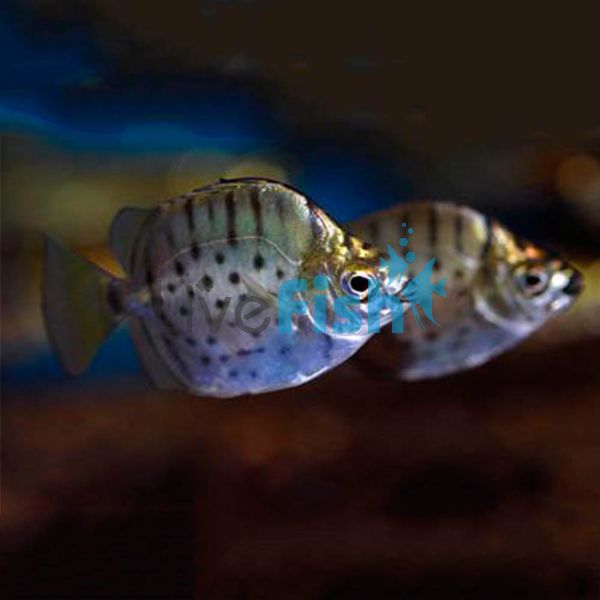Silver Scat 3cm - Brackish
The Silver Scat is a fun and captivating species from the brackish and freshwater regions of Southeast Asia and Northern Australia. Scats are a great scavenger out in the wild eating plant matter, dead fish, and even faeces. These underrated fish are a surprisingly great addition to cichlid tanks due to their large size of 40 cm and boisterous behaviour.
- Buy 2 for $38.12 each and save 10%
- Buy 4 for $36.00 each and save 15%
- Buy 8 for $33.88 each and save 20%
Silver Scat
The Silver Scat is a fun and captivating species from the brackish and freshwater regions of Southeast Asia and Northern Australia. Scats are a great scavenger out in the wild eating plant matter, dead fish, and even faeces. These underrated fish are a surprisingly great addition to cichlid tanks due to their large size of 40 cm and boisterous behaviour.
The Silver Scat is like Australia’s version of the South American silver dollar in visuals. These fish have a large disk-shaped body with bright, shimmering silver skin. The silver is highlighted with a sheen of light green across the back and fins. The most contrasting aspect of these fish is the set of vertical black barring they have above the lateral line, below this is a bunch of spots that break up the silver nature of these fish. The Silver Scat's eyes are another notable feature, large and expressive, adding to its curious and engaging demeanour. These fish are incredibly hardy and can tolerate a wide range of water parameters which is why they are so versatile in the aquariums they can be kept in.
Breeding Silver Scats in captivity can be challenging due to their specific salinity requirements. These fish are egg layers and tend to spawn in slightly salinity water. The young, interestingly, require varying degrees of salinity at different stages of their development, which can complicate rearing efforts. These fish are almost always wild-caught but adapt incredibly well into aquariums.
Tank Recommendations for your Silver Scat
A minimum tank size of 350 litres is recommended for Silver Scats, as they need ample space to swim and thrive. These are incredibly active fish and can quickly become a wet pet. They associate their owners with food quickly and come right up to the glass, due to this their large footprint really dictates a larger aquarium. Silver scats can be kept in a full freshwater setting for their whole life in an aquarium but in the wild are most often found in a brackish water setting with a specific gravity of about 1.005 to 1.010. The aquarium setting is not too much of a concern as these fish can be found in everything from a river setting to even the mouth of full saltwater environments. A sand or gravel substrate will be perfectly fine with the use of driftwood and river stones.
Suitable Tank Buddies
The Silver Scat is generally sociable and can coexist with many fresh and brackish water species. The only issue is that these fish are especially active and boisterous so they should be paired with other medium to large fish that can tolerate these activity levels. At times scats are said to be nippy fish so it is best to avoid long-finned or delicate fish.
Usually Compatible
Barramundi, Australian Lungfish, Freshwater Stingrays, Severum, Oscar, Silver perch, and other larger, semi-aggressive fish.
Sometimes Compatible
Smaller - medium-sized cichlids or native Australian rainbows could have the risk of being pestered by the scat
Rarely Compatible
Nano nano fish because it’s almost certain that the scat may outcompete them. Some species are too aggressive for Saratoga such as Murray Cod or Dovii cichlids.
Feeding your Silver Scat
Silver scats are one of the most opportunistic feeders in the aquarium hobby and will readily eat a wide range of foods both dry, fresh, and frozen. Their diet should contain good quality pellets with high contents of spirulina or greens but they will eat anything. Feeding these fish once a day will be perfectly fine.
Is Silver Scat Venomous?
Yes - Dorsal Spines contain mild amounts of venom. It is best to avoid being pricked by them and handled with care.
| Scientific Name | Selenotoca multifasciata |
|---|---|
| Care Level | Easy |
| Common Names | Silver Scat |
| Diet | Omnivore |
| Fish Family | Scatophagidae |
| Lifespan (years) | 20 |
| Max. Length (cm) | 40 |
| Min. Tank Volume (l) | 350 |
| Origin | Australasia |
| Reef Safe | No |
| Sociability | Peaceful |
| Venomous | Yes |
| Water Conditions | 24-28° C, pH 5.0-7.0 |




